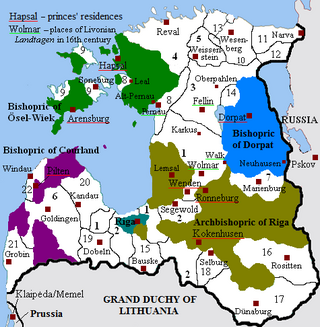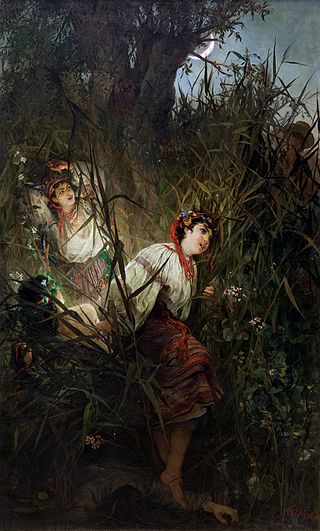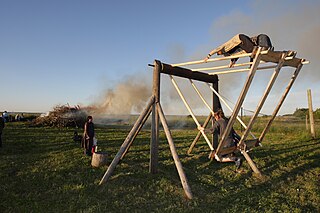
Livonia or in earlier records Livland, is a historical region on the eastern shores of the Baltic Sea. It is named after the Livonians, who lived on the shores of present-day Latvia.
Adya Hount'tò is a loa associated with drumming in West African Vodun.
Seneca mythology refers to the mythology of the Seneca people, one of the six nations of the Iroquois Confederacy from the northeastern United States.
Finnish mythology is a commonly applied description of the folklore of Finnish paganism, of which a modern revival is practiced by a small percentage of the Finnish people. It has many features shared with Estonian and other Finnic mythologies, but also shares some similarities with neighbouring Baltic, Slavic and, to a lesser extent, Norse mythologies.

Pärnu is the fourth largest city in Estonia. Situated in southwest Estonia, Pärnu is located 128 kilometres (80 mi) south of the Estonian capital, Tallinn, and 176 kilometres (109 mi) west of Estonia's second largest city, Tartu. The city sits off the coast of Pärnu Bay, an inlet of the Gulf of Riga, which is a part of the Baltic Sea. In the city, the Pärnu River drains into the Gulf of Riga.

Pärnu County is one of 15 counties of Estonia. It is situated in the south-western part of the country, on the coast of Gulf of Riga, and borders Lääne and Rapla counties to the north, Järva and Viljandi counties to the east, and Latvia to the south. In 2022 Pärnu County had a population of 85,705 – constituting 6.4% of the total population of Estonia.

Other than the many gods and goddesses of the Slavs, the ancient Slavs believed in and revered many supernatural beings that existed in nature. These supernatural beings in Slavic religion come in various forms, and the same name of any single being can be spelled or transliterated differently according to language and transliteration system.

Marie Under was one of the greatest Estonian poets. She was nominated for the Nobel Prize in Literature in 12 separate years.

Peko is an ancient Estonian and Finnish god of crops, especially barley and brewing. In the area of Setumaa, between Estonia and Russia, inhabited by the Seto language-speaking Setos, the cult of Peko was alive until the 20th century. Today, the Seto people also revere Peko as their national hero and king, the name and figure are widely used as a national symbol.
Estonian mythology is a complex of myths belonging to the Estonian folk heritage and literary mythology. Information about the pre-Christian and medieval Estonian mythology is scattered in historical chronicles, travellers' accounts and in ecclesiastical registers. Systematic recordings of Estonian folklore started in the 19th century. Pre-Christian Estonian deities may have included a god known as Jumal or Taevataat in Estonian, corresponding to Jumala in Finnish, and Jumo in Mari.
All official holidays in Estonia are established by acts of Parliament.

David Binney is an American alto saxophonist and composer.

The culture of Estonia combines an indigenous heritage, represented by the country's Finnic national language Estonian, with Nordic and German cultural aspects. The culture of Estonia is considered to be significantly influenced by that of the Germanic-speaking world. Due to its history and geography, Estonia's culture has also been influenced by the traditions of other Finnic peoples in the adjacent areas, also the Baltic Germans, Balts, and Slavs, as well as by cultural developments in the former dominant powers, Sweden, Denmark and Russia. Traditionally, Estonia has been seen as an area of rivalry between western and eastern Europe on many levels. An example of this geopolitical legacy is an exceptional combination of multiple nationally recognized Christian traditions: Western Christianity and Eastern Christianity. The symbolism of the border or meeting of east and west in Estonia was well illustrated on the reverse side of the 5 krooni note. Like the mainstream cultures in the other Nordic countries, Estonian culture can be seen to build upon ascetic environmental realities and traditional livelihoods, a heritage of comparatively widespread egalitarianism arising out of practical reasons, and the ideals of closeness to nature and self-sufficiency.
The earliest mentioning of Estonian singing dates back to Saxo Grammaticus' Gesta Danorum. Saxo spoke of Estonian warriors who sang at night while waiting for a battle. Henry of Livonia at the beginning of the 13th century described Estonian sacrificial customs, gods and spirits. In 1578 Balthasar Russow described the celebration of midsummer (jaanipäev), the St. John's Day by Estonians. In 1644 Johann Gutslaff spoke of the veneration of holy springs and J.W. Boecler described Estonian superstitious beliefs in 1685. Estonian folklore and beliefs including samples of folk songs appear in Topographische Nachrichten von Liv- und Estland by August W. Hupel in 1774–82. J.G von Herder published seven Estonian folk songs, translated into German in his Volkslieder in 1778 and republished as Stimmen der Völker in Liedern in 1807.

The fern flower is a magic flower in Baltic mythology, in Estonian mythology and in Slavic mythology.
Finnic mythologies are the mythologies of the various Finnic peoples:
The Vishap (Վիշապ) is a dragon in Armenian mythology closely associated with water, similar to the Leviathan. It is usually depicted as a winged snake or with a combination of elements from different animals.
Nesaku is kami in Japanese mythology. In many versions he is from the blood of Kagutsuchi. He is a minor star god.

Pseudo-mythology are myths and deities which do not exist in genuine mythology and folklore or their existence is doubtful or disproved. It may be created by researchers who liberally interpret scarce sources.









